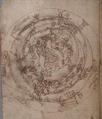Planisphere facts for kids
A planisphere is a special kind of map used in astronomy. It helps you see what the night sky looks like at any time of the year. Think of it as a flat, round tool that shows the celestial sphere (the imaginary sphere where all stars and planets appear to be located) flattened out onto a flat surface. Because it's flat, you can't see every single part of the sky at once, but it's very useful for finding stars and constellations. An ancient Greek astronomer named Hipparchus found a way to make these maps so that the angles between stars stay correct.
Contents
What is a Planisphere?
A planisphere is a simple, hand-held tool that helps you learn about the stars. It usually has two main parts: a round base disc and a transparent (see-through) top disc. The base disc shows a map of the stars and constellations. The top disc has an oval window cut out of it. This window represents the part of the sky you can see from your location at a specific time.
How Does a Planisphere Work?
To use a planisphere, you turn the top disc until the date on the base disc lines up with the time on the top disc. Once they are lined up, the stars and constellations visible in the oval window are the ones you can see in the real sky at that moment. It's like having a mini-planetarium in your hands!
Why Use a Planisphere?
Planispheres are great for beginners in astronomy because they are easy to use and don't need batteries or electricity. They help you:
- Find constellations and bright stars.
- Learn when certain stars will be visible.
- Understand how the night sky changes throughout the year.
- Plan your stargazing sessions.
History of the Planisphere
The idea of projecting the sky onto a flat surface goes back a very long time. Early astronomers used similar tools to track the movements of stars and planets.
Who Invented the Planisphere?
While the exact "inventor" of the modern planisphere isn't known, the principles behind it come from ancient Greek and Islamic astronomers. The Greek astronomer Hipparchus, who lived around 190-120 BC, was important for his work on projecting the celestial sphere. Later, Islamic scholars developed and refined these tools, creating complex instruments that could predict star positions.
Evolution of Star Maps
Over centuries, these early star maps evolved. In the Middle Ages, people used devices like the astrolabe, which was a more complex tool but shared some ideas with the planisphere. The modern planisphere, as we know it today, became popular in the 20th century as a simple and affordable way for everyone to explore the night sky.
Images for kids
-
Medieval planisphere, c.1000. National Library of Wales MS 735C, Aberystwyth.
See also
 In Spanish: Planisferio celeste para niños
In Spanish: Planisferio celeste para niños



